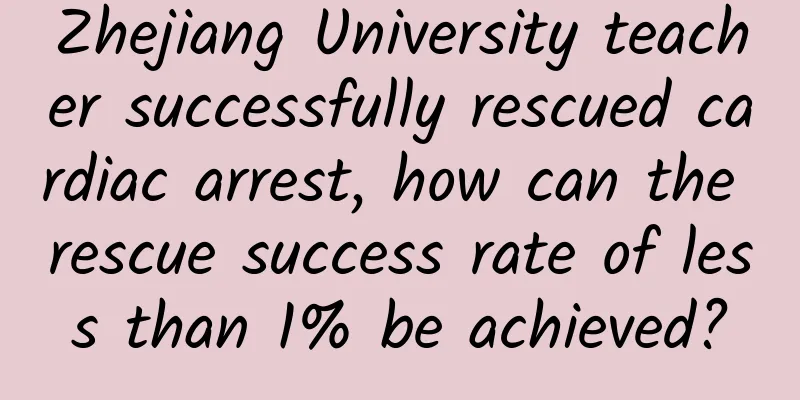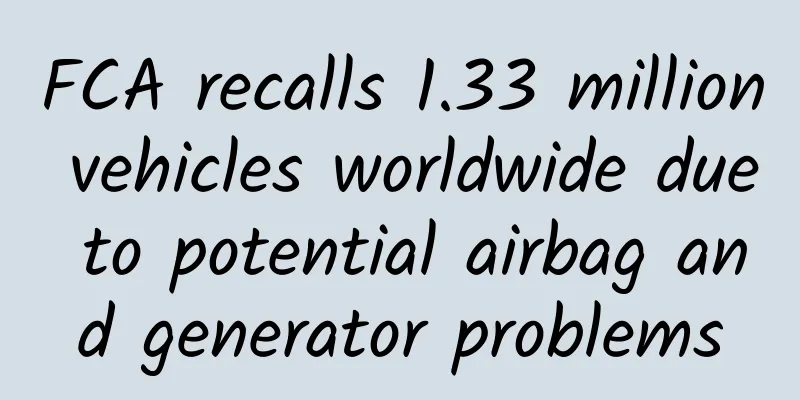Zhejiang University teacher successfully rescued cardiac arrest, how can the rescue success rate of less than 1% be achieved?

|
On the evening of September 2, at Zhejiang University's Zijingang Campus, the School of Medicine was playing a friendly football match with the School of Civil Engineering. In the second half of the game, Teacher Chen from the School of Civil Engineering fell to the ground after a violent kick. Other teachers and students hurried to Teacher Chen and found that he was pale, his lips were purple, and his breathing and heartbeat were very weak. "We immediately called 120 and asked Teacher Chen to lie down while we started looking for an AED near the playground." Zeng Xun, a researcher at Zhejiang University First Hospital, and Pan Yibin, an assistant researcher at Zhejiang University Affiliated Shaw Hospital, who were playing football together, immediately started first aid for Teacher Chen. Recalling the scene at that time, the two still have lingering fears: "We were really nervous because it was the first time we encountered such a thing in real life." After the 120 call was connected, dispatcher Wu Haiming quickly learned the details from the students' calm description and immediately instructed the teachers and students on the scene to give first aid to the patient through a video call. "Faster! Faster! At least two times per second, press down at least 5 centimeters deep." In the dispatch hall, Wu Haiming clearly explained the key points and precautions of the first aid action. On the court, Zeng Xun and Pan Yibin, one was responsible for artificial respiration and the other for cardiac compression, and they did not dare to stop for a moment. Four or five minutes later, the AED was brought to the scene by the students. Following the dispatcher's instructions and the frequency of the AED, everyone continued to perform first aid until the ambulance arrived and the doctor took over. At this moment, Teacher Chen had regained consciousness. After emergency treatment, his breathing and heartbeat slowly recovered. Only then did the teachers and students feel relieved. According to the doctor who received the patient, 60-year-old Mr. Chen had severe coronary atherosclerosis in his heart, and exercise may have been a triggering event, leading to acute myocardial infarction. "The probability of being saved in this case is less than 1%. Thanks to the people on the scene who took emergency measures in time and used the AED correctly, Mr. Chen was able to escape danger." What is cardiac arrest? Cardiac arrest refers to the sudden cessation of the heart's ejection function, the disappearance of large artery pulsation and heart sounds, and severe ischemia and hypoxia of important organs (such as the brain), leading to the end of life. This unexpected sudden death is also called sudden death in medicine. The most common cause of cardiac arrest is ventricular fibrillation. If the patient does not respond when called, and there is no response when pressing the supraorbital or infraorbital area, it can be determined that the patient is in a coma. Then pay attention to observe whether the patient's chest and abdomen have ups and downs and breathing movements. If there is no pulsation when touching the carotid artery and femoral artery, and no heartbeat can be heard in the precordial area, it can be determined that the patient has cardiac arrest. How to provide first aid for cardiac arrest? When sudden death happens around us, the rescue method of effective artificial respiration and chest compression for this emergency is called cardiopulmonary resuscitation , abbreviated as CPR . In our country, about 544,000 people suffer from cardiac arrest every year, and an average of one person dies suddenly every minute. This emergency can happen at any time, any place, and anyone. Once cardiac arrest occurs, all organs of the human body will be deprived of oxygen. Our brain will suffer irreversible damage once it is deprived of oxygen for four or five minutes. Even if the heartbeat is restored later, it may become a vegetable. Therefore, the golden rescue time for cardiac arrest is 4 minutes, which is called the "golden 4 minutes". For every minute of delay, the chance of survival of the injured person decreases by 10% . According to a survey, the success rate of rescuing out-of-hospital cardiac arrest in China's major cities is only about 1% , while the average in developed countries is about 10%, and in some cities and regions it is as high as 30-50%. One of the main reasons for this gap is the low penetration rate of public first aid in China. The first witnesses at the scene lack the necessary first aid knowledge and skills, making it difficult to save lives and reduce injuries to the greatest extent, and to create conditions and gain time for treatment by professional medical institutions. Hands-free cardiopulmonary resuscitation is an operation that is easy to master and can quickly and effectively treat the wounded. In recent years, the country has also actively promoted and popularized it. Key points of CPR 1: Chest compressions Operation steps: confirm the safety of the environment, identify cardiac arrest, activate the emergency response system, start CPR as soon as possible, and perform early defibrillation. (1) Environmental safety: First, when helping others, you must protect yourself first and make sure that the on-site environment is safe and suitable for rescue. For example, you can evacuate pedestrians around you first. If you are on the road, you must put up warning signs to allow other vehicles to bypass. (2) Judgment: Next, we start to judge the reaction. We kneel on the ground, pat the patient's shoulders, and shout loudly next to his ear. If the patient does not respond at this time, we will open his clothes, observe whether the chest is rising and falling, and judge the pulse by touching the carotid artery. We need to check the pulsation of the carotid artery (non-professionals do not need to check). Under normal circumstances, you can feel the carotid artery by putting two fingers on both sides of the midline of the neck. This place is close to the heart, so the pulsation will be very strong. Once the heart stops beating, you will not be able to feel the pulse. If the patient is unresponsive, the chest is not rising or falling, and there is no arterial pulse, we must perform CPR immediately. (3) Activate the emergency response system: It is very difficult to save lives with our own hands, so we must seek help from people around us. Designate someone around you to call 120 and clarify your location, while another person goes to get an automated external defibrillator. Currently, automated external defibrillators have been deployed in public places in Zhengzhou, such as subway stations. (4) Start CPR as soon as possible: ① The chest compression position is at the midpoint of the line connecting the two nipples. Use the heel of your palm to press, cross your hands and lift them up, straighten your forearms and upper arms without bending them, and press down with your upper limbs perpendicular to the patient's body. The compression depth for adults is 5 to 6 cm. The frequency is 100-120 times per minute. ② Open the airway. Before ventilation, we must first clean the patient's oral and nasal secretions. We generally use the head tilt and chin lift method. For patients who may have cervical spine injuries, we use the jaw support method. ③ Artificial respiration. While opening the airway, blow air into the patient. When blowing, pinch the patient's nasal cavity with your hands. The rescuer covers the patient's mouth with his own mouth, and then blows evenly and slowly for 2 times. When blowing, be careful not to take a deep breath and blow it out violently. Instead, inhale calmly and blow air slowly. When you see the patient's chest bulge, the blowing is effective. Each blowing time should not be less than 1 second, and the blowing volume is about 500 to 600 ml. Chest compressions and artificial respiration should be performed in a ratio of 30:2, that is, 2 artificial respirations should be performed after every 30 chest compressions. It should be noted that if the patient is a child or an infant, the compression and breathing ratio of a single person rescuing is the same as that of an adult. If two people are rescuing at the same time, the compression and breathing ratio should be changed to 15:2, that is, 2 artificial respirations should be performed after every 15 chest compressions. (5) Early defibrillation (automatic external defibrillator): The automatic external defibrillator can automatically analyze the heart rate and determine whether the patient needs defibrillation. If necessary, it will automatically perform defibrillation. ▲The pressing position is the midpoint of the line connecting the two nipples, or the lower half of the sternum ▲Place the base of one hand in the pressing position ▲Cross your hands and hold them tightly, with four fingers raised 1 ▲Cross your hands and hold them tightly, with four fingers raised 2 ▲Stretch your arms straight and press vertically downward CPR operation point 2: artificial respiration There are two commonly used methods of artificial respiration, mouth-to-mouth respiration and mouth-to-nose respiration. 1. Mouth-to-mouth breathing Choose a method to open the airway according to the patient's condition. The patient lies in a supine position, and the rescuer puts one hand on the patient's forehead and pinches the patient's nostrils with the thumb and index finger. With the other hand, he holds the chin to tilt the head back as much as possible to keep the airway open. Then take a deep breath, open your mouth to close the area around the patient's mouth (infants and young children can be covered together with the nose), and blow air into the patient's mouth twice continuously. Each time the air is blown for 1 to 1.5 seconds, with a volume of about 1000 ml, until the chest cavity rises, stop blowing, release the patient's mouth, and relax the hand pinching the nostrils, turn the face to the side, listen with your ears to see if there is any airflow exhaled, take a deep breath of fresh air to prepare for the second blow, and when the patient has finished exhaling, start the same blow again. If the patient has not recovered spontaneous breathing, continuous air blowing should be performed. The frequency of air blowing for adults is 12 times/minute, for children is 15 times/minute, and for infants is 20 times/minute. However, it should be noted that the air blowing volume is more important than the air blowing frequency. The first two air blowings should last 1 to 2 seconds each. Allow the gas to be completely expelled before blowing again. Check the carotid pulse, pupil and skin color within one minute until the patient recovers, or dies, or is ready for intubation. 2. Mouth-to-nose breathing When the patient has oral trauma or other reasons that prevent the mouth from opening, mouth-to-nose blowing can be used. The operation method is: first open the patient's airway, tilt the head back, and hold the patient's lower jaw with your hand to close the mouth. Take a deep breath, cover the patient's nose with your mouth, and blow air into the patient's nostrils forcefully until the chest rises. After blowing, open the patient's mouth and let the gas exhale. If the blowing is effective, you can see the patient's chest rise and fall with the blowing, and you can feel the airflow exhaled. How long should CPR be performed? Will it cause harm (breaking the patient's ribs)? If you encounter a patient with respiratory and cardiac arrest, please continue to press and blow until the patient recovers spontaneous breathing and heartbeat, or professional medical personnel arrive to take over the rescue work. Cardiopulmonary resuscitation is very physically demanding, so before the medical staff arrives during the rescue process, you must actively seek assistance and cooperation from people around you. When we are doing CPR, we may have some concerns about whether the patient will be harmed during the rescue process, such as breaking the patient's ribs, and whether we need to bear legal responsibility? If the rescuer causes damage to the person being rescued due to voluntary emergency rescue, the rescuer shall not bear civil liability. Therefore, if you encounter someone who needs rescue, please step forward bravely to rescue him. Comprehensive sources: People's Daily Online, Dahe.com, Science Encyclopedia, etc. |
<<: Science and technology empowers ships to spread the concept of green development
Recommend
One man guards the pass, ten thousand men cannot open it: the small mouth actually hides such a complex ecological environment
Open your mouth in front of the mirror and look a...
How is the advertising fee of Douyin Star Map calculated? Douyin Star Chart Advertising Fee Billing Method Revealed
Self-media and short videos are very popular nowa...
The "unspoken rules" of App Store operation, promotion and marketing
A few days ago, a very suspicious business simula...
Sony MDR-1000X pushes BOSE off the altar to create the most powerful Bluetooth noise reduction
When it comes to noise-canceling headphones, many...
vivo Xplay 3S video and audio review
In terms of playing high-definition videos, domest...
Is it true that the sun once had a twin?
The Sun is the only star in our solar system, but...
SEO diagnostic service case: 2020 iherb discount code website to make dollars!
Case screenshots: My senior asked me to help opti...
80% of affected users may abandon iPhone: Are US companies the biggest victims of the "WeChat ban"?
Trump's blockade policy against Chinese techn...
I advise you to try Guizhou Matcha, just one reason is enough!
Matcha ice cream, matcha latte, matcha yogurt... ...
Windows licensing fees may drop to $42 in 2020
Microsoft recently released a free version of its ...
Annual review | 3 key words for brand marketing in 2019
Introduction: Frequent collaborations, frequent h...
In the iPhone era, facial recognition technology is hard to ban
San Francisco supervisors voted to amend the law ...
Community business operation model: IP + community + scenario + sharing economy
The community is the shortest path for every bran...
Emma Technology's annual masterpiece, Emma A7Plus is about to be released
As the annual masterpiece of Emma Technology, wha...
Cultivate the blue land! Use the "materials" of a great country to support the "deep blue dream" of the ocean
Produced by: Science Popularization China Author:...









